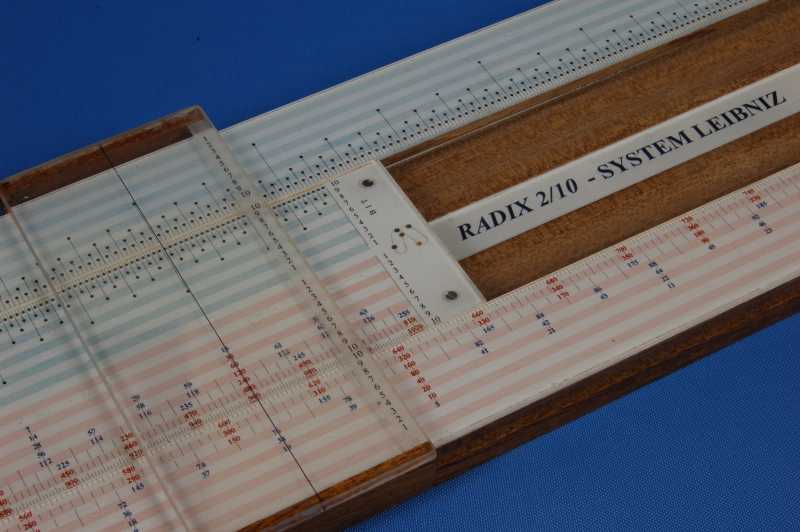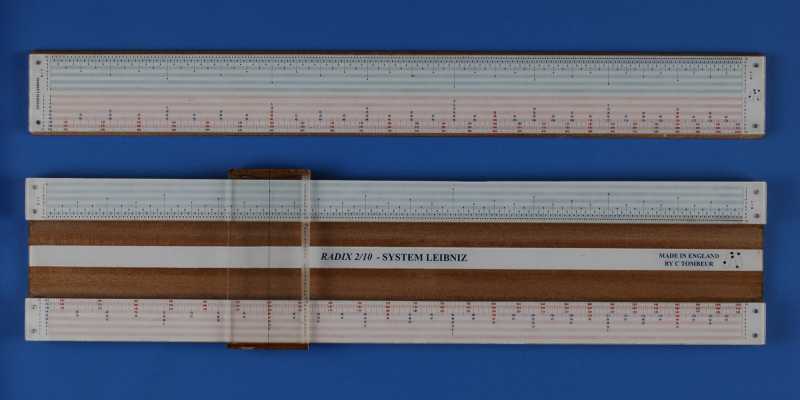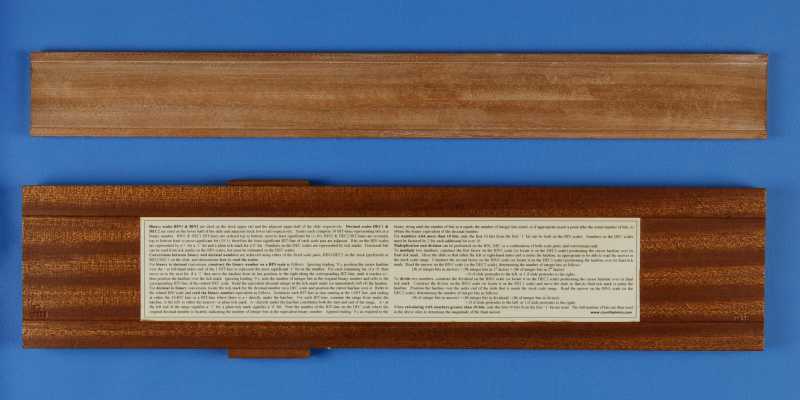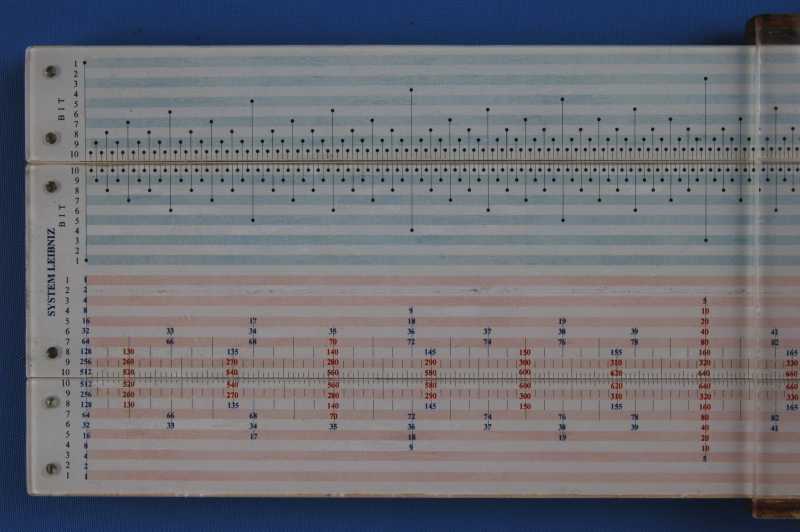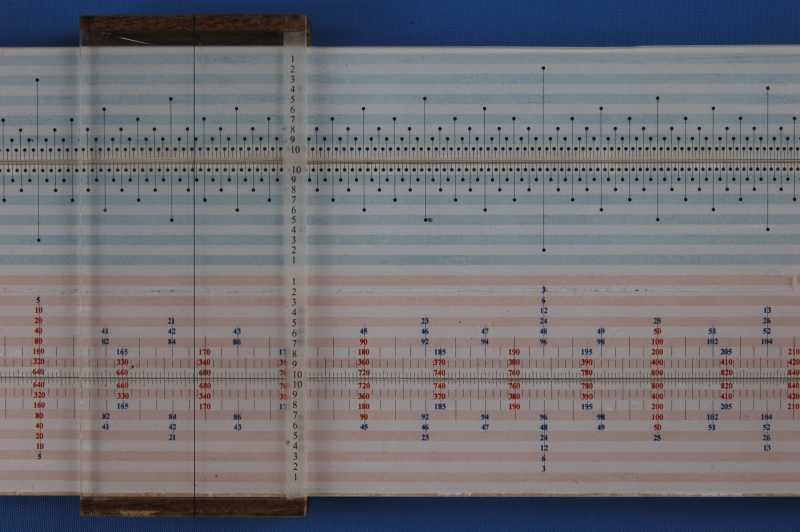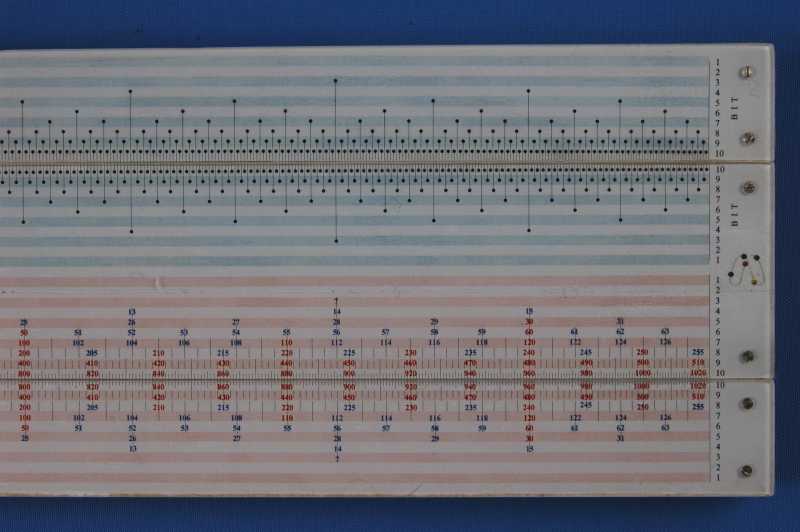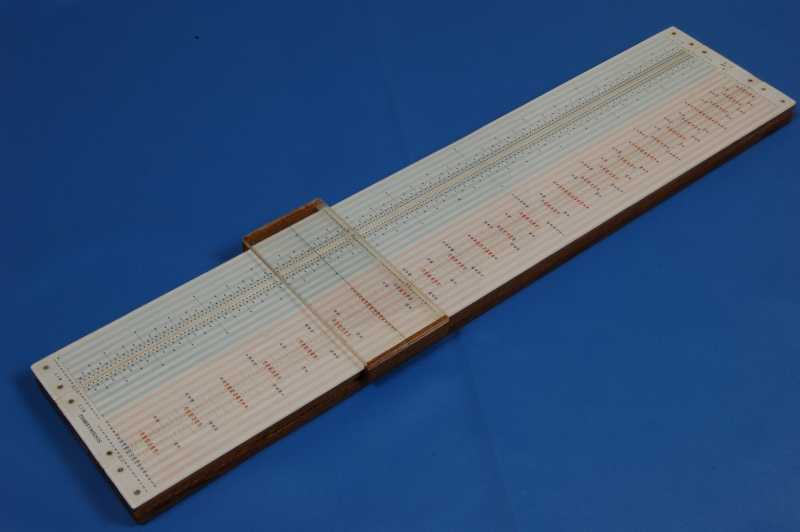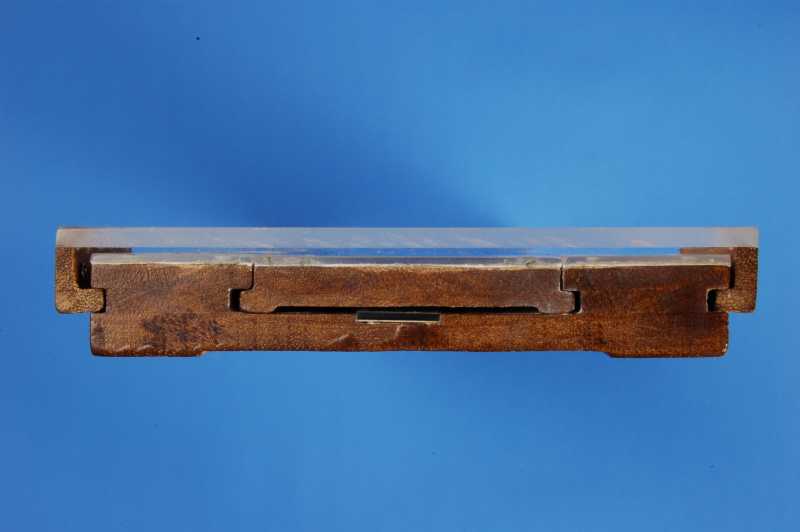Radix Series Slide Rules
& "SYSTEM LEIBNIZ"
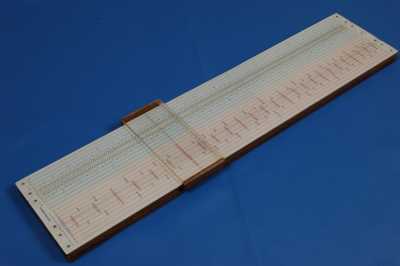
The Radix model series of slide rules is an idea based around a scale layout that I designed.
The layout consists of a logarithmic primary pair of scales in one base, with which multiplication and division can be performed in a similar way to a 'standard' slide rule, and an equivalent pair of scales in a different base for conversion purposes. In theory, any two bases can be chosen for the scales and calculations and conversions performed.
The scales are positioned with the primary pair on the upper rail of the stock and adjacent upper edge of the slide, and the equivalent pair on the lower edge of the slide and lower rail of the stock. Each scale consists of a number of lines representing the digits in a number, which are arranged such that the lines of the least significant bits of each scale pair are adjacent.
The idea of the Radix model series came about after I had designed this scale layout for a 10 bit logarithmic binary slide rule with decimal conversion scales, and realised it could be used for any two different bases. This model was then named the Radix 2/10, since 'radix' is another term for 'base' and 2/10 refers to binary/decimal. The particular construction of the logarithmic binary scales and how they represent 'bits' rather than numerals is named 'SYSTEM LEIBNIZ' after Gottfried Leibniz who discovered the modern binary number system.
Currently the Radix 2/10 System Leibniz, 10 bit binary/decimal desktop rule is the only model in the series which has been made. A detailed specification is given below under 'Models Detail' along with links to instructions and a detailed paper describing the background, design and operation of the rule under 'Documents'.
The paper was published under the title "Extreme Sliding - Base Jumping with the Radix 2/10 Binary/Decimal Slide Rule" in the Issue 15 Autumn 2014 edition of the UK Slide Rule Circle's Slide Rule Gazette, and seperately in the Proceedings of the 20th International Meeting of Collectors of Historical Calculating Instruments, where it was presented in September 2014 in Delft, the Netherlands. There is also a link to an old overview document that has been superceded by the paper and instruction documents.
If interested in this or a different variation, please contact me via the email address on the
contact page.
Additional slide rule material can be accessed using the links in the left bar under "Slide Rule Content Pages".
Models Summary
Below is a complete list of all Radix models ever made. Multiple entries within a model number indicates multiple versions/examples. Click on a model to jump down to its description:
|
Brand
|
Model No
|
Description
|
Material1 |
Scale
mm
|
(Top Face Length x Width mm) |
Year
|
(years
produced) |
|
C Tombeur
|
2/10 |
System Leibniz, desktop binary/decimal
|
W/X
|
390
|
(420 x 92) |
2013
|
(2013- ) |
1 A = Aluminium; C = celluloid; L = painted; P = plastic; W = wood; X = Perspex
Documents
All documents are A4 size PDF, but the instructions are designed to be printed as an A5 booklet. Click to open the PDF or link:
Models Detail
Click on the image to view a gallery.
2/10 (2013) |
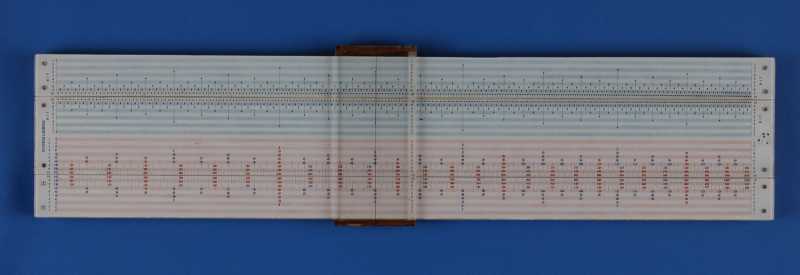
|
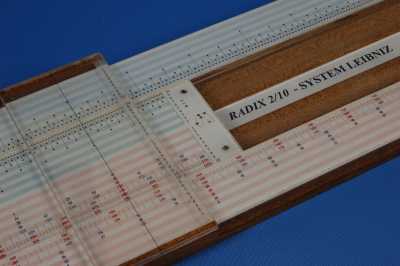
|
Summary
|
|
System:
|
System Leibniz
|
|
Specialization:
|
-
|
|
Type:
|
Closed frame
|
|
Material:
|
Mahogany laminate
|
|
Facings:
|
Perspex/paper
|
|
Scale Length:
|
39cm
|
No of Scales:
|
4
|
|
Front Length:
|
420mm
|
Front Width:
|
92mm
|
|
Language:
|
English
|
Origin:
|
England
|
|
Date:
|
2013, October
|
|
Features/Notes:
|
Desktop logarithmic 10 bit binary rule with decimal conversion.
|
|
Scales (colours as shown) |
|
Front:
|
§1 [ §2, §3 ] §4 |
Back:
|
-
|
|
Labels Left:
|
BIT 1 2 3 4 5 6 7 8 9 10 [ BIT 10 9 8 7 6 5 4 3 2 1, 1 2 3 4 5 6 7 8 9 10 ] 10 9 8 7 6 5 4 3 2 1
|
Labels Left:
|
-
|
|
Labels Right:
|
BIT 1 2 3 4 5 6 7 8 9 10 [ BIT 10 9 8 7 6 5 4 3 2 1, 1 2 3 4 5 6 7 8 9 10 ] 10 9 8 7 6 5 4 3 2 1
|
Labels Right:
|
-
|
|
Style:
|
Multi-line
|
Typeface:
|
Serif
|
|
Extensions:
|
-
|
Decimals:
|
-
|
|
Gauge Marks:
|
-
|
Rulers:
|
-
|
|
Features/Notes:
|
Printed on paper with Perspex facing.
§1 scale on upper stock rail is a specialist 10 bit logarithmic binary scale, comprising 10 lines (1 for ech bit) where a '1' bit is indicated with a '•', ordered most to least significant bit.
§2 scale on upper edge of slide is a specialist 10 bit logarithmic binary scale, comprising 10 lines (1 for ech bit) where a '1' bit is indicated with a '•', ordered least to most significant bit.
§3 scale on upper edge of slide is a specialist equivalent decimal scale, comprising 10 lines of integer tick marks, ordered most to least significant bit.
§4 scale on lower stock rail is a specialist equivalent decimal scale, comprising 10 lines of integer tick marks, ordered least to most significant bit.
Alternate lines of the binary scales are shaded light blue for ease of reading.
Alternate lines of the decimal scales are shaded light red for ease of reading.
Numbers on the decimal scales are blue, with multiples of 10 in red for ease of location.Integers are labelled as follows : all 1-6 bit integers (1-63); even 7-BIT integers (64-127); 8-BIT integers divisible by 5 (128-255); 9-BIT integers divisible by 10 (256-511); 10-BIT integers divisible by 20 (512-1023); all powers of two.
|
|
Construction
|
|
Stock:
|
Solid stock constructed from laminated 3.2mm and 6.4mm thick mahogany strip to make well and slide and cursor grooves.
Upper and lower rails equal widths (mm) - 24
12mm wide rebate in well with paper/Perspex facing.
Front and well rebate faced with 1mm Perspex.
Paper scales and Perspex fixed with clear double-sided tape and anchored with M1.2 machine screws, two each at left & right ends of upper and lower rails (8 in total).
High cursor grooves.
No bevel to top and bottom edges.
Shallow rebate in back for paper tables.
Varnished excluding sliding contact surfaces and Perspex.
Length x Width x Height (mm) - 420 x 92 x 14
|
|
Slide:
|
Single sided
Constructed from laminated 3.2mm mahogany strip to form locating tongue.
Shallow rebate in back to reduce friction.
Front faced with 1mm Perspex.
Paper scales and Perspex fixed with clear double-sided tape and anchored with M1.2 machine screws, two each at left & right ends (4 in total).
Varnished excluding sliding contact surfaces and Perspex.
Front face width (mm) - 44
|
Cursor:
|
Single central black hairline.
3mm thick Perspex pane attached to seperate top and bottom runners.
Runners fashioned from laminated 3.2mm mahogany strip.
Varnished excluding sliding contact surfaces and Perspex.
Steel spring on top runner, mounted at left end with a M1.2 machine screw.
Width x Height (mm) - 45 x 100
|
|
Printing (colours as shown) |
|
Stock:
|
"RADIX 2/10 - SYSTEM LEIBNIZ" in centre of well.
"MADE IN ENGLAND BY C TOMBEUR" + juggling pattern logo at right end of well.
|
|
Slide:
|
"SYSTEM LEIBNIZ" vertically at left end.
Juggling pattern logo at right end.
|
|
Cursor:
|
-
|
|
Labels:
|
On back, summary instructions, with footer "www.countbelmiro.com"
On cursor, "1 2 3 4 5 6 7 8 9 10 10 9 8 7 6 5 4 3 2 1 1 2 3 4 5 6 7 8 9 10 10 9 8 7 6 5 4 3 2 1" line number reference sticker on right edge of underside of pane.
|
|
Instructions
|
|
Model overview with summary instructions and examples can be downloaded from the link above.
|
|
Box (colours as shown) |
|
Style:
|
None
|
L x W x D mm:
|
-
|
|
Material:
|
-
|
Colour:
|
-
|
|
Construction:
|
-
|
|
Printing:
|
-
|
|
Labels:
|
-
|
|
Detail Images
|
|
Click on the images for enlargements.
Click on the images for enlargements.
Click on the images for enlargements.
Click on the images for enlargements.
Click on the images for enlargements.
Click on the images for enlargements.
Click on the images for enlargements.
Click on the images for enlargements.
|
 The Radix model series of slide rules is an idea based around a scale layout that I designed.
The Radix model series of slide rules is an idea based around a scale layout that I designed.
